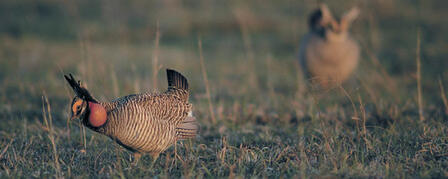LESSER PRAIRIE CHICKEN POPULATION SURVEYED RANGE-WIDE

October 11, 2012
First statistically-valid lesser prairie chicken survey completed
PHOENIX, ARIZ. – The lesser prairie chicken is an iconic grassland grouse species native to parts of Colorado, New Mexico, Texas, Kansas and Oklahoma. However, long-term population declines have brought state and federal agencies together in an attempt to better manage lesser prairie chickens and their habitats. Through a multi-state collaborative effort, the first statistically-valid, range-wide population estimate for the lesser prairie chicken has been produced, according to the Western Association of Fish and Wildlife Agencies’ (WAFWA) Grassland Initiative. The range-wide lesser prairie chicken population is estimated at 37,170 individuals.
The WAFWA Grassland Initiative collaborated with the Lesser Prairie Chicken Interstate Working Group, which is composed of biologists from state fish and wildlife departments within the range of the species, the Bureau of Land Management, and West Ecosystems, Inc. of Laramie, Wyo., to conduct a large-scale, helicopter-based survey of lesser prairie chicken leks across all five states. Leks are sites that the birds go to every spring for breeding. These surveys occurred from March-May and encompassed more than 300,000 square miles.
Survey results will be the baseline for a range-wide lesser prairie chicken management plan currently being developed by the five state wildlife agencies in collaboration with the WAFWA Grassland Initiative. This plan is expected to be completed by March 2013, and could influence the U.S. Fish and Wildlife Service’s (Service) decision on whether or not to designate the lesser prairie chicken as a federally threatened or endangered species. The lesser prairie chicken has been considered a candidate under the Endangered Species Act (ESA) since 1998, and the Service expects to release a proposed rule on the status of the bird under the ESA in November 2012.
While the lesser prairie chicken population estimate may appear low, biologists are encouraged by what they found. The surveys this spring detected several previously unknown leks, despite severe drought conditions across the region last year. They also discovered leks in Kansas beyond what was thought to be the northern limit of the historic range of the species. Lesser prairie chicken numbers have been largely increasing in Kansas for the last 15 years, while populations have declined in parts of the southern portion of the range. Biologists believe this expansion may represent a northward shift in the population of the species caused by climatic conditions associated with changing precipitation patterns.
“Historically, we saw habitat conditions like we are observing now in the 1930s, and we thought the species went extinct”, said Bill Van Pelt, WAFWA Grassland Coordinator. “However, with habitat conservation programs being implemented through various Farm Bill programs and Candidate Conservation Agreements under the Endangered Species Act, we are seeing lesser prairie chickens maintaining themselves and even expanding into new areas in some parts of their range. This definitely boosts our confidence in coming up with a plan to maintain this species”, concludes Van Pelt.
The final survey report is available at http://www.wafwa.org/html/aerial_surveys.shtml. Media Contact: Bill Van Pelt (602-717-5066)
-30-









